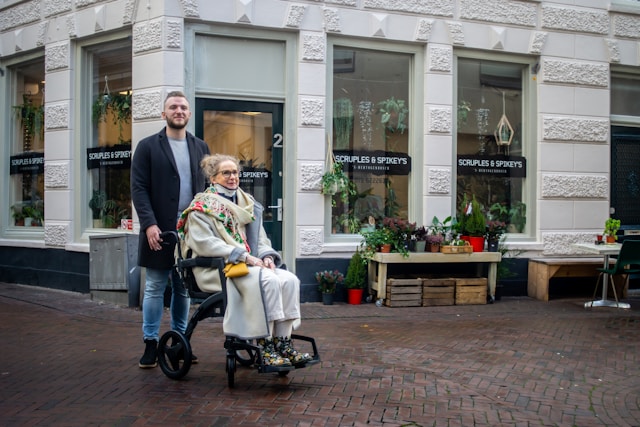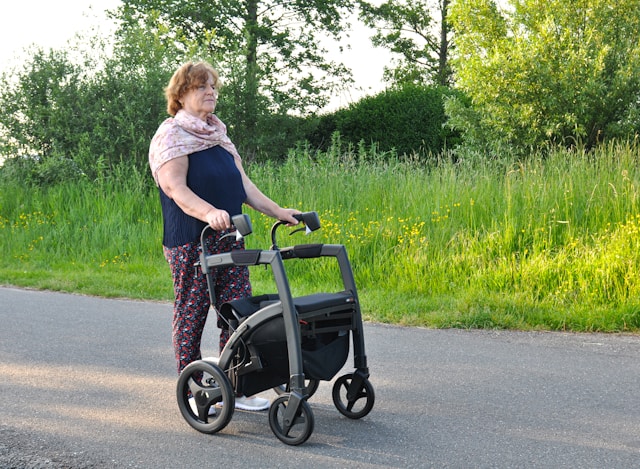
How Parkinson’s Disease Progresses
Parkinson’s disease is a condition that affects how our bodies move. It happens because certain nerve cells in the brain stop working properly, which leads to less dopamine, a chemical that helps control movement. As a result, Parkinson's disease symptoms, such as shaking, stiffness, and slower movements, develop over time. No two people with Parkinson’s are exactly the same. Some might notice small changes over years, while others find that their symptoms worsen more quickly. That’s why it’s so important to understand how the disease can progress, so everyone involved, whether you’re living with Parkinson’s, caring for someone, or supporting families, can be prepared and make the best choices. Understanding how and why Parkinson's disease happens, including the gradual loss of dopamine and the emergence of symptoms, highlights the importance of early detection and intervention.
There are lots of ways to manage Parkinson’s symptoms. Medicines can help with movement, and therapies such as physiotherapy or occupational therapy can make daily life easier, especially in managing non-motor symptoms. For some, treatments like deep brain stimulation (a type of surgery) might be suggested if other options aren’t enough. Learning about Parkinson’s, and knowing what to expect, is crucial because parkinson can progress differently for each person and significantly impact both patients and their families. It helps people with the condition, their families, and their support teams work together to maintain as full and active a life as possible.
Understanding Disease Progression
Parkinson’s disease doesn’t look the same for everyone. Some people notice changes coming on quickly, while others find things shift more slowly over the years. This makes it hard to predict exactly how the condition will unfold for any one person, but knowing the general patterns can help you feel more prepared.
Doctors often talk about Parkinson’s using five typical stages, called the Hoehn and Yahr scale:
Stage 1: This is considered the early stage, where mild symptoms usually affect only one side of the body. You might notice a slight tremor or a change in facial expression, but daily life isn’t much different.
Stage 2: Symptoms begin to appear on both sides. Movements may feel stiffer, and tasks can take a little longer, but most people are still managing on their own.
Stage 3: This is often when balance problems and falls begin. Everyday activities like getting dressed or eating might become trickier, and you might need a bit of support.
Stage 4: At this stage, severe symptoms are present. People often need help with daily tasks and may use a walker to get around.
Stage 5: This is the debilitating stage and represents the most advanced stages. Getting up and moving around is very difficult, and a wheelchair is usually needed. Most people need full-time care.
Not everyone will experience all the symptoms, and symptoms may not occur with the same intensity in every person. The progression and severity of symptoms can vary widely.
It’s important to remember that not everyone will go through all these stages, and the timeline can be very different from person to person. Some people stay in the early stages for many years. The Hoehn and Yahr scale helps describe the stages of Parkinson's disease, but individual experiences may differ.
The main symptoms of Parkinson’s include both motor symptoms (like tremors, stiffness, and slow movement) and non-motor symptoms (such as sleep problems, memory changes, and mood shifts), and both can get worse over time. Non-motor symptoms can even start years before movement issues appear, and they’re just as important to watch for. Deep brain stimulation is a treatment option that may be considered in the later stages, especially when medication becomes less effective and tremors persist.
Real-World Example in Michael J. Fox’s Parkinson’s Journey
Sometimes, hearing about someone else’s experience can make things clearer. Michael J. Fox, the well-known actor, has become one of the most recognisable faces of Parkinson’s disease. He was diagnosed at just 29 years old, which is much younger than most people with Parkinson’s. Over the years, he’s shared his journey openly, helping many people understand what living with the condition can really look like.
Initially, Michael noticed small changes, such as a twitch in his finger and some stiffness in his shoulder. These early signs are common for many people with Parkinson’s. As time went on, his symptoms gradually became more noticeable and started affecting both sides of his body. He’s talked about how daily activities, like walking and speaking, have become more challenging as his condition has progressed. Parkinson's patients in advanced stages often face similar difficulties, including severe stiffness, mobility impairments, and even neuropsychiatric symptoms such as hallucinations and delusions.
Michael’s story is a poignant reminder that Parkinson’s disease can progress slowly or rapidly, and that everyone’s journey is unique. He’s also shown how important it is to adapt, seek support, and stay positive, even when things get tough, considering the risk factors involved . Through the Michael J Fox Foundation, he’s helped raise awareness and support research, offering hope to others living with Parkinson’s. By looking at real-life examples like Michael J. Fox, families and carers can better understand the ups and downs of Parkinson’s and see that, while the road can be challenging, support and community can make a big difference.
Motor Symptoms
Motor symptoms are often the most noticeable signs of Parkinson’s disease, and they can change over time, illustrating how movement symptoms affect overall wellbeing. These symptoms are usually what prompt people to seek a diagnosis in the first place, as each symptom can manifest and progress differently.
Some of the most common motor symptoms include:
Tremors: Shaking, often starting in one hand or finger, especially when the muscles are at rest.
Stiffness (Rigidity): Rigid muscles may feel tight or inflexible, making it harder to move freely.
Bradykinesia (Slowness of Movement): Everyday tasks like buttoning a shirt or walking can take longer than before.
Balance and Coordination Problems: As Parkinson’s progresses, it’s common to feel unsteady on your feet, which can lead to more frequent falls. Changes in a person's posture and poor posture are also contributing factors.
Other movement symptoms, such as changes in gait or difficulty with fine motor skills, can also occur. These parkinson’s disease symptoms can make daily life more challenging, not just for the person with Parkinson’s but also for their loved ones and carers. Simple activities, like getting dressed, eating, or even writing, may require more time and patience.
Managing motor symptoms is a big part of living with Parkinson’s. Medications can help improve movement and reduce tremors, while physical and occupational therapy can teach strategies for staying active and independent. For some people with more advanced symptoms, treatments like deep brain stimulation surgery may be an option.
It’s important to remember that everyone’s experience is different. Some people may have mostly tremors, while others deal more with stiffness or balance issues. Keeping an eye on these changes and working closely with healthcare professionals can help manage symptoms and maintain quality of life.


Non-Motor Symptoms
While movement problems are often the first thing people think of with Parkinson’s, non-motor symptoms can be just as challenging—and sometimes even more so. These symptoms don’t involve movement, but they can have a big impact on daily life and wellbeing. Non-movement symptoms, such as sleep disturbances, loss of sense of smell, and constipation, can appear years before motor symptoms and are crucial for early detection and understanding of the disease's progression.
Some common non-motor symptoms include:
Sleep Problems: Trouble falling asleep, staying asleep, experiencing sleep disorders, or noticing changes in sleep patterns, or feeling rested in the morning, is very common.
Cognitive Changes: Some people may notice difficulties with memory, concentration, or problem-solving as time goes on.
Mood and Mental Health: Feelings of depression, anxiety, or apathy can affect people with Parkinson’s at any stage.
Digestive Issues: Constipation and other stomach problems are frequent and can be uncomfortable.
Loss of Sense of Smell: Many people notice this even before movement symptoms appear.
Fatigue: Feeling very tired, even after a good night’s sleep, is a common complaint.
Other symptoms, such as cognitive changes and sleep disturbances, may not be captured by traditional motor-focused scales, highlighting the need for comprehensive evaluation tools that include both motor and non-motor symptoms to better understand the full spectrum of Parkinson's disease effects.
These symptoms can appear at any stage of the disease, sometimes even before noticeable changes in movement are evident. They can make everyday tasks harder and may affect relationships, work, and social life.
It’s important for people with Parkinson’s and their families to talk about these symptoms with their healthcare team. Many non-motor symptoms can be managed with medication, therapy, and lifestyle changes. Addressing them early can make a big difference in overall quality of life and help everyone involved feel more supported and understood
Muscle Stiffness
Muscle stiffness is one of the most common symptoms of Parkinson’s disease, and it can make everyday life more difficult. People often describe it as a feeling of tightness or resistance when they try to move their arms, legs, or even their trunk. Sometimes, this stiffness can make it hard to get out of a chair, walk comfortably, or reach for things.
Stiffness doesn’t always affect both sides of the body equally. It might start on one side and gradually spread, or it might be more noticeable in certain parts of the body. For some, it’s a mild annoyance; for others, it can really limit independence and comfort. In severe cases, rigid muscles can make daily tasks impossible, as everyday activities become unmanageable without assistance.
There are several ways to manage muscle stiffness:
Medications: Doctors may prescribe medicines like anticholinergics or dopamine agonists to help relax muscles and improve movement. It’s important to talk about any side effects with your care team.
Therapies: Physical and occupational therapy can make a big difference. Therapists can show you stretches and exercises to keep your muscles flexible and help you move more easily.
Lifestyle Changes: Staying active is key. Gentle activities like walking, swimming, or yoga can help reduce stiffness and keep joints moving. Even simple daily stretching can make a big difference.
If you or your loved one is struggling with muscle stiffness, don’t hesitate to ask for help. Your healthcare team can work with you to find the right combination of treatments and activities to keep you as comfortable and mobile as possible.
The Timeline of Parkinson’s Disease
Parkinson’s disease is different for everyone, and the timeline of symptoms and progression can vary widely. Some people notice changes over just a few years, while others, like Michael J. Fox, live with the condition for decades, experiencing a slow and gradual progression of symptoms, including impaired body movement. These symptoms originate and spread within the nervous system, particularly affecting neurons in areas such as the gut and olfactory system, and eventually leading to degeneration in specific regions of the brain.
In the early stages, symptoms might be mild and only slightly affect daily life. Over time, both motor symptoms (such as tremors and stiffness) and non-motor symptoms (including sleep disturbances or mood changes) can become more pronounced and begin to impact everyday activities. Some people may stay in the early or middle stages for many years, while others progress more quickly.
It’s important to remember that there’s no “one-size-fits-all” timeline when considering genetic and environmental factors. Factors like age at diagnosis, overall health, and even genetics can influence how quickly or slowly Parkinson’s progresses. For example, Michael J. Fox was diagnosed at a young age and has managed his symptoms for over 30 years, showing that with the right support and care, people can live well with Parkinson’s for a long time.
Understanding the possible timeline helps families and carers plan ahead—whether that means making home adjustments, considering extra support, or simply being ready for changes as they come. Staying informed and working closely with healthcare professionals can make the journey smoother for everyone involved.
As Parkinson’s disease progresses, it’s natural for care needs to change. Many people find that, over time, managing symptoms at home becomes more challenging, especially as movement, balance, and communication are affected by various environmental factors. Parkinson’s disease treatments, particularly levodopa, can also impact blood pressure, sometimes causing low blood pressure and increasing the risk of orthostatic hypotension, so monitoring for these side effects is important. Families and carers often work incredibly hard to provide support, but there can come a point where extra help is needed to ensure everyone’s wellbeing.
Residential care can offer a reassuring solution, providing a safe and supportive environment where people with Parkinson’s receive personalised attention from a team who understand the condition’s complexities. At Cherrybrook Care Home, residents benefit from experienced staff, tailored care plans, and a warm, homely atmosphere that helps maintain dignity and independence for as long as possible. The opportunity to take part in therapies and social activities, while having access to round-the-clock care, can make a real difference to quality of life.
Choosing residential care is a big decision, but it can bring peace of mind for both individuals and their families. If you’re considering the next step for yourself or a loved one, Cherrybrook Care Home is here to offer guidance and support every step of the way, please get in touch if you would like a private tour of our home.
